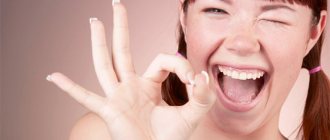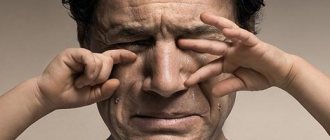Very often, in stressful situations, people begin to blush. Some people experience a slight blush on their face, but others' faces turn purple. Therefore, the question often arises: “Why does a person blush?” Redness of the skin of the face can be associated with various processes in the body or with situations occurring independently of you. Having studied all possible available facts, you can identify the reasons for this process and answer the question of how to stop blushing.
Causes of redness
Why does a person blush? Facial redness is a natural reaction. This is how the body reacts when worried or stressed. This most often happens to young people and girls during adolescence. Redness of the skin can be explained by the regulation of small blood vessels and capillaries, which dilate, increasing the volume of blood passing through them. This happens when a person is worried.
In this case, the cheeks, ears, neck, and forehead may become very red. In rare cases, redness appears not only on the skin, but also on the eyes, and sometimes unevenly. The reasons for blushing lie in the depths of consciousness and depend on the social adaptability of a person. In simple words, a blush on the face is a sign that a person is afraid of society and others.
The face turns red: what happens at this moment
In some situations, the body reacts to stress by increasing the heart rate and increasing blood flow, which causes the face to immediately turn red. Why exactly the face, and not the arms, legs, back, for example? The fact is that there are significantly more blood vessels on the face, and the skin is thinner, so the body’s reaction to a rush of blood quickly manifests itself in redness, noticeable to others.
Redness manifests itself in different ways: for some, cheekbones “flare up”, for others the entire face (forehead, eyes, ears, neck), and for others it becomes covered with bright red spots. One way or another, this is an unpleasant situation in which a person may break into a hot or cold sweat, may have dark vision, and a “cottoniness” may form in the muscles of the body.
The blushing person begins to feel awkward. It seems to him that everyone is looking at him and laughing at his redness (although in reality this is far from the case). He begins to put his palms to his face, fanning himself with the first object that comes to hand - a newspaper, a notebook. By performing such actions, a person attracts even more attention to himself, and the redness not only does not go away, but also intensifies.
The thing to remember is that most people don't care about your excitement and redness. Research has long shown that a significant part of society is focused solely on themselves, and not on others. Therefore, if you simply develop the habit of not reacting to your own blushing, few people will notice it. Well-mannered people will pretend that nothing happened to your appearance, and perhaps they will even become more lenient (if you speak publicly or defend some important project).
Getting rid of redness
How to stop blushing? First you need to determine what type of problem: psychological or physical. Then you must definitely visit qualified specialists who can prescribe treatment against redness.
If the reason is psychological, and there is no desire to go to a psychologist, wasting your time and money, then there are special techniques for training and getting rid of constant blushing in public.
Method one: unmasking
Why does a person start to blush? First of all, a person begins to blush because he wants to hide the upcoming redness. One of the most effective methods is the unmasking method. Its essence lies in the fact that a person, feeling the beginning of redness, is the first to pay attention to it, which leads to a stunning effect - the redness subsides very quickly.
A person’s ruddy, red face speaks of the natural expression of true feelings. That is, if he says something, but in his soul the attitude towards the object of attention is the opposite, then redness begins to appear. Drawing attention to your problem of blushing first is scary only in your thoughts, since those around you will not even give any hint of what they have noticed, because they themselves have their own problems in their heads and it is unlikely that any of them are eager to take it upon themselves also the problems of another person.
Method two: composure
The essence of the method is self-control and composure in relation to facial redness. As you know, a person takes responsibility for what his subconscious generates. Just like the subconscious, the conscious mind is responsible for some things that happen to people, such as hiccups, blinking or speaking in a rude manner.
But how can you learn not to blush? It’s easy, you just have to separate the subconscious and conscious processes in your head. Because a person can control, or at least try to control, hiccups, blinking and rude speech, for which consciousness is responsible. But it is impossible to control the subconscious, so it is worth saying once and for all that a person cannot order his subconscious to stop creating redness.
Method Three: Managing Blood Flows
Yes, perhaps controlling blood flow sounds too unrealistic, but once you try it, this opinion will disappear. For example, you can imagine a large fire near your frozen hands that can warm them. Having imagined such a picture, the brain will send an impulse and blood will begin to flow into the hands, thereby warming them.
In order to get rid of facial redness, you should imagine a fire near your hands at the right moment. Thanks to this, the blood will flow to the hands, and the face will take on a normal appearance and get rid of redness. This method is very popular in the problematic issue of how not to blush when talking with your interlocutor.
Method four: calmness
This method is based on the phenomenon of self-suggestion. If, before an important speech, report or other activity in front of the public, a person experiences anxiety while preparing, then he unconsciously sends a signal to the brain so that during the speech the speaker will have the same state of excitement as during preparation. Based on this, to solve the problem of blushing, you simply need to imagine the speech calm and confident during preparation. In this case, the brain will send an impulse that is responsible for the lack of excitement.
Method five: back to the past
The essence of the method is that a person remembers past times when he blushed. Then he watches it from the side. Now it is important to realize the possibility of changing memories. Remember those events again, but take away the redness and excitement from them, and that everything ended well. Thanks to this exercise, a signal is sent to the brain that there was no history of anxiety. Only consciousness will “remember” this. The subconscious will be convinced of the opposite.
Method six: focusing on the subject
Having mastered this method, you can forget about anxiety and the symptoms that it entails. This method is suitable for those who are afraid to speak in front of a large audience in a large hall. The speaker pays attention to numerous looks and faces, which confuses and makes his face blush.
To avoid this, it is enough to imagine that the auditorium is empty, only the speaker is standing on the stage. Also, another little trick could be for the person standing in front of the audience to focus on one object or place in space. Using this method, you can become a professional in your field.
Do not be shy
Many, speaking about this peculiarity of theirs, admit that I am almost always embarrassed, even because of the fleeting glance of a random passerby.
What can we say about situations when you have to speak in public, have an important conversation, look your boss in the eye... Some may blush because of someone else’s mistake, and then the person thinks that his reddened face “screams” about guilt or misconduct. And sometimes, to blush, it’s enough just to remember your natural inclination. But you can learn to live with this feature. And psychologists are unanimous: you just need to allow yourself to blush without feeling shame! — The fear of blushing manifests itself in a public place when a person is not alone, —
says
psychotherapist Ekaterina Averkova.
“
Moreover, this condition can develop from fear itself, that is, without any serious preconditions. A person is afraid to blush and blushes even more: because others will see it and can somehow evaluate and interpret it. Anxiety increases, and over time the situation can worsen: people fall into a stupor when an interlocutor approaches them, this can lead to anxiety disorders, fear of visiting public places, speaking, and depression.
Where does erythrophobia come from? As psychotherapists like to say, everything comes from childhood.
“Most likely, the child didn’t even notice that he was blushing,”
says Ekaterina Averkova.
“We all blush, but not everyone attaches such great importance to it.” But if someone told the child about this, laughed and gave some kind of social assessment, then next time he may be afraid of repeating the situation. The reaction is consolidated, this will be accompanied by an excessive feeling of shame, the fear of being a laughing stock, hurt or weak.
Exaggerated blushing
A person susceptible to blushing experiences only two problems: the appearance of a ruddy complexion and the reaction of others to this. As numerous studies say, the second problem is the most serious, because the scarlet color confuses a person, and he tries to hide it or even get away from his interlocutors. This entails problems with society, because the situation calls into question communication with peers. In this case, social phobia develops.
Such behavior is wrong, since in any case the attitude of others towards the issue raised is unknown; maybe they don’t care or they like it. A good solution to this problem would be to ask your social circle how they feel about blushing when talking. The answers will differ from those expected. Indeed, in ninety-nine percent of cases, blushing only decorates the appearance, making it more prettier.
Cuperosis
Corr:
Is it possible to confuse Blushing syndrome with rosacea?
Yes, it is not uncommon for patients to make mistakes when diagnosing themselves. Erythrophobia and rosacea are completely different situations of facial redness. In the second case, this is a feature of dilated blood vessels, the so-called “spider veins,” which appear on the face in a bright red and purple pattern. Their presence has nothing to do with those preceding factors (excitement, embarrassment, fear, etc.) characteristic of erythrophobia. This problem (rosacea) should be solved cosmetically.
Physiological problems
If the problem with blushing is not related to psychology, then it means that it is physiology. There is a well-known disease called rosacea. It is a vascular pathology that appears due to poor blood circulation. Thus, the face can turn red not only with excitement and embarrassment, but also with temperature changes, heat, frost and other factors, and sometimes no reason is needed for this.
The pathology itself is not dangerous. The consequences of neglect are dangerous. If you do not pay attention to it, the vessels will burst, forming spider veins, very noticeable and difficult to disguise. In addition to rosacea, there are other physiological pathologies for which you should definitely contact a qualified doctor to take action.
Why do my cheeks turn red?
To the question “Why do my cheeks turn red?” Doctors do not give a clear answer. Psychologists believe that this is how the body reacts to stress if there are signs of social phobia or fear of communication. In some cases, there may be a risk of developing erythrophobia - fear of a “red face”. Therapists, as such, do not consider temporary redness of the skin of the face to be a separate disease. The reasons may lie in other health conditions.
It is noted that cheeks often turn red in adolescence and young people, this is due to changes in hormonal levels and the body’s reaction. With age, such a reaction occurs much less frequently or is less pronounced.
But this is all individual. If, in addition to redness of the cheeks, a person generally feels a deterioration in health (rapid heartbeat, chest pain, increased sweating, nervous tremors), it is worth paying attention to your health and visiting a neurologist, cardiologist or therapist. Some types of examinations and tests will help to understand the true cause of the redness; if signs of the disease are detected, the doctor will prescribe appropriate treatment.
One of the reasons for facial redness may be rosacea. The only difference is that when rosacea occurs, the face turns red not only when excited, it always has a reddish tint. This is due to poor patency and loss of elasticity of facial blood vessels. When the capillaries cannot withstand the pressure and burst, vascular stars form under the skin, and this additionally changes the complexion.
You can prevent the development of rosacea in the following ways:
- increase the amount of vitamins in the diet. Multivitamins with a high content of K, P, C have the most positive effect on improving the circulatory system. Fresh fruits, herbs, vegetables, rich in antioxidants, will help improve the health of blood vessels and restore their elasticity.
- Periodically take a course of medications containing rutin (ascorutin is one of the most accessible and budget-friendly). This substance strengthens blood vessels, prevents their fragility and increases patency.
- Introduce physical activity into your life. With moderate sports, the circulatory system in general and blood vessels in particular are healed and strengthened.
- Do not perform cosmetic procedures that injure the skin if you are prone to rosacea. Use mild cleansers and sponges, creams with antioxidants and vitamins, and be sure to use sunscreen lotions and emulsions. Monitor the level of hydration of your facial skin.
One way or another, there are ways to overcome facial redness, and many of them can be tried on your own.
Beta blockers
The use of medication also gives good results in the fight against erythrophobia. Antidepressants are popular among medications to help you stay calm in stressful situations. Sometimes, the patient is prescribed beta blockers, which are initially intended to treat problems with the heart and blood pressure. Their essence is to block adrenaline and, naturally, redness of the face. However, the drugs cannot be taken constantly, as they will negatively affect the body. They are used only when an important event is planned.
It is important to understand that conservative methods will not completely eliminate stress redness. As soon as a person stops taking the pills, the result of stimulation of the sympathetic nervous system in moments of embarrassment, excitement or irritation may again appear on the face. Such treatment methods will help to cope with the phobia and reduce the frequency of redness. To achieve the best effect, all experts recommend an integrated approach.
Corr:
That is, you won’t be able to get rid of stress redness through the use of psychology?
Of course no. This sign of the body is not based on psychological problems. It originates at the physiological level of an uncontrolled reaction. Therefore, it will not be possible to get rid of it using this method. I repeat, conservative treatment can only cope with erythrophobia, as well as reduce the incidence of redness.











